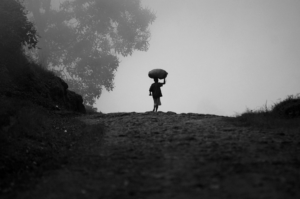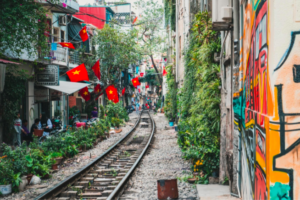The only way to really appreciate the Great Wall of China is to stand on its walls and stare in awe…
Much is written about the Great Wall of China that simply isn’t true. It doesn’t stretch across the whole country in a straight line from left to right; it can’t be seen from the moon; it’s not 10,000 miles long; and it isn’t, for the most part, neatly castellated – except in the most frequently-visited tourist sections. One of the most enduring icons of China’s past, it is in fact a complex piece of heritage that in its grandeur and sheer paranoia represents the best and the worst of the Chinese world-view.
Largely a Ming Dynasty project to connect a range of existing walls built to defend scattered border towns from marauding tribes to the north, the number of lives wasted in its centuries-long construction is one of history’s longest-lasting atrocities – and it could be said that the Great Wall was, in the end, a complete failure: the forces that eventually displaced the Ming simply talked their way through one of its gates.
Most visitors to the Wall get only a postcard-like overview of the structure from the summit at Badaling, the closest section to Beijing where tourists are rewarded, quite frankly, with what they expect to see. Standing at the highest point in the morning sunlight, a traveler can see the Wall snaking away across the mountains, punctuated by symmetrical watchtowers in stunning regularity; majestic, beautiful, and a little too perfect. Follow the wall with your eyes until it vanishes over a distant peak, and you may wonder just how far it goes, and what else there is of the Wall to see beyond this one prettified stretch with its chairlifts and refreshments stands. Answering that question not only provides you with a fascinating China travel itinerary – it will teach you more about modern and ancient China than you might expect.
Where Eagles Climb
The Jiankou section is genuinely untouched and unrestored. This is hiking Wall, where you’ll be clambering over fallen bricks and inching your way up near-vertical mountain faces. One of the highest lookout towers is known as the Ying Fei Dao Yang – which means that even an eagle flying to the tower has to fly straight up to reach it. Most of the rises have no handrail or any other protection – and as the slope is dangerously steep, you’ll need to take the utmost care in climbing. From the highest point at the Zhengbei Tower, you’ll be ideally placed to spot any armies marching on Beijing.
The Jiankou Great Wall was built in 1368, and the white cliff rock used in its construction makes this section stand out rather strikingly against the heavily forested hillsides, making it one of the most photogenic stretches. You can camp out the night in one of the towers, if you like – it’ll take a couple of days to cover, so this actually isn’t a bad option in warmer weather.
The best thing about this section of the Wall is that it’s free – there’s no cover charge at all – meaning you’ll be able to enjoy being witness to genuine history without feeling like a tourist.
All Rubble and Clay
Zhangjiakou’s a smoky little town where the taste of burning coal infiltrates every breath of air and every bowl of rice, but it has a bare, spacious atmosphere that will leave you with a warmhearted (albeit gritty) vision of a China quite distinct from what you’ll find in other more well-trodden tourist towns. Climb up one of the many hills surrounding the city to really appreciate the remoteness, simplicity and dignified decay that typifies Zhangjiakou.
Its position at one of the Wall’s most strategically important passes has given the city a significant role in Chinese history as the gateway to the former southern border of old Mongolia. In dynastic times, all traffic through to Mongolia was controlled here; more recently, it was the temporary provincial capital of Inner Mongolia until the borders changed and that honor fell to Hohhot, leaving Zhangjiakou to crumble in the northwestern corner of Hebei.
Apart from the pass itself, the Zhangjiakou Wall is completely unrestored and quite distinctive – it’s not castellated and there’s no pathway along the top – in fact, most of the Wall here is a simple barricade of reddish clay rock, loosely mortared together, around two or three meters thick. The watchtowers resemble muddy honeycombs, cylindrical in shape. A tourist pathway alongside the wall leading to Shuimu Palace, a temple in the east of the city, is an easy climb. The slopes behind the palace afford nice views of the surrounding countryside, and mark the entrance to Zhangjiakou’s ‘Underground Great Wall’ – disappointingly, a short tunnel.
Where Flowers bloom
If you want to see the Wall at its prettiest, Huanghuacheng is the spot. Overgrown with sweet yellow flowers in the summer and stretching high above a natural spring lake and crescent-shaped water reservoir, this is a beautifully-preserved section of the Wall favored by nature lovers all year round. The reason it’s still in such good shape is that it was built solidly with a special additive in the mortar made from rice glue – a slow and expensive move that cost the chief engineer his head when it was suggested to the Emperor he’d neglected his duties and wasted funds. It wasn’t until the Emperor decided to take a look for himself that he realized his mistake and built the poor fellow a better tomb, erecting a monument at the Wall engraved with the characters jin tang, meaning ‘firm’. This is still called the Jin Tang Wall by locals, and despite having been bombed by the Japanese during the war, it still lives up to its name.
That being said, the paths are far from pristine – this is 430-year-old masonry – but the climb isn’t terribly steep until you get higher up, and in some parts the walk is very pleasant, and you’ll be at ease to enjoy the scenery.
Mathematical Precision
Situated at the northern tip of Tianjin Municipality, the Huangyaguan Wall features some unusual architecture and unique watchtower design, a result of principally strategic imperatives. This was an important pass in ancient times that required superb defense facilities, and the small city built at the pass to accommodate militia (now refitted to accommodate tourists, and quite nicely too) was fixed with traps and wrong-turns to confuse any invaders who made it through.
Huangyaguan is another steep and tough section of the Wall, but it was repaired during the mid-eighties in the interests of preserving its rare features, making climbing much safer (although no less of a challenge). It’s a particularly old section, first built in 557AD, and so the city of Tianjin regards it as a key relic. Many of its more interesting features – in particular the water pass and the fascinating Baguaguan Castle – have been completely restored.
Huangyaguan is noted for its peculiarly austere beauty and mathematically precise nature. At some points you’ll see its jagged reflection in the river below, and standing on the clifftop, you’ll see quite clearly how well- designed this defensive structure is – it was once boasted that as long as one man guarded Huangyaguan, ten thousand could not pass through it.
The Underwater Wall
The northern border of Greater Tangshan follows the path of the Great Wall all the way from Qinhuangdao in the East to Tianjin in the West, and its condition is relatively poor. However, the Xifengkou pass near the Panjiakou reservoir makes for an interesting visit, most famous for a stretch of the Wall that has been completely submerged underwater. Characterized by almost obliterated Wall sections that stretch between curiously well-preserved watchtowers, the Wall descends into the reservoir quite suddenly, and depending on water levels, can be seen clearly as a ghostly silhouette of ancient glories.
Apart from the underwater section, there’s an interesting triple-gateway near the Nuan River valley and a recently-constructed memorial to the section’s contribution to modern military history at the main gate.
In early 1933, Chinese forces under Zhao Dengyu found the pass as strategically valuable as had the Emperors of long ago when they staged successful resistance attacks against the Japanese here – only to be betrayed a few months later when the Guomindang signed an agreement with the Japanese and ordered the withdrawal of all strategic Great Wall defense forces. If you look carefully, you can still find bullet holes in the Wall here.
This is remote and staggering Wall territory, and the presence of other tourists is rare – apart from the odd tour group brought in to see the parts underwater, you can be sure to find places far away from anyone to be alone on the Wall.
Across the bridge
In 1998, the Chinese government took out a loan from the World Bank to make repairs on cultural relics – the funds were used to restore a very unusual section of the Great Wall at Jiumenkou. Officially tied to Huludao city in southern Liaoning province, the Wall here is notable for its 100m span across the Jiujiang River – the only part of the Great Wall that resembles and functions as a bridge.
The name means ‘nine gateways’ and refers to the nine sluice gates making up the pass across the river. This section of the Wall dates back to 1381, but is based on earlier walls constructed around 550AD. Visitors to Jiumenkou rarely choose to climb the mountainside Wall here, usually just dropping in to see the nine-gate river pass – but if you do want to make a longer visit out of it, there’s two kilometres of fairly easygoing and fully-restored Wall with sixteen watchtowers and a beacon tower to explore. Jiumenkou makes for a nice afternoon and is an easy part of the Wall to conquer.
Taking Tiger Mountain
Hushan is a little farther away from the capital, and it’s best tacked on to a visit of Dandong city, an overnight train trip from Beijing. It was only recognized as the true eastern terminus of the Great Wall in 1992, and extensive renovations were carried out after the fact.
As a reconstruction, the Hushan Wall looks brand new. The original Wall here was built with soil, wood and stones, which is why it’s had to be speculatively rebuilt using common features seen at other sections in its design.
It may seem fake if you’re a purist, but it’s a genuine attempt to restore something once lost – and the climb rewards with some quite impressive views of the North Korean countryside. Once you’ve scrambled down to the far end of the Wall, you’ll come to a shallow creek which marks the border – on the other side, uniformed border guards on second-rate bicycles are on patrol with some scary-looking guns.
Into the Ocean
Perhaps one of the most compelling places to go and see the Wall is at the Old Dragon’s Head – where its brick spine topples down the last mountain slope and dives into the sea. Shanhaiguan is the only part of the Great Wall you can see at the beach – fully restored to its former glory (where possible using the original bricks) and jutting into the waves with imposing military splendor.
Shanhaiguan city is latched onto the Wall along its eastern side and is protected by some commanding stone figures of Ming dynasty soldiers positioned along the fortifications. The real defenders may have let their guard down for the Manchu invaders when they breezed their way through here in 1644, but their modern-day stone counterparts lend an authentic air to a city one imagines has not changed much since those times. Shanhaiguan is still all marble pathways and old courtyards – it has a genuine atmosphere that other walled cities have now lost to the tourist trade, and visitors here often leave with the impression that they’ve seen some of the real China at last.
Finally making your way up the stairs to the Head and walking its last hundred meters to the end (or rather, the beginning) of the Great Wall is the climax of the itinerary.
The Wall tapers to an edge of less than a couple of meters wide, and it’s just enough to comfortably stand and gaze out at the ocean from the archer’s gap in the stone. If you do want to make a special experience out of your visit to the Old Dragon’s Head, come out at dawn and watch the sun rise over the sea – you’ll feel, just as those old soldiers once did, like you’re at the beginning of the world.







